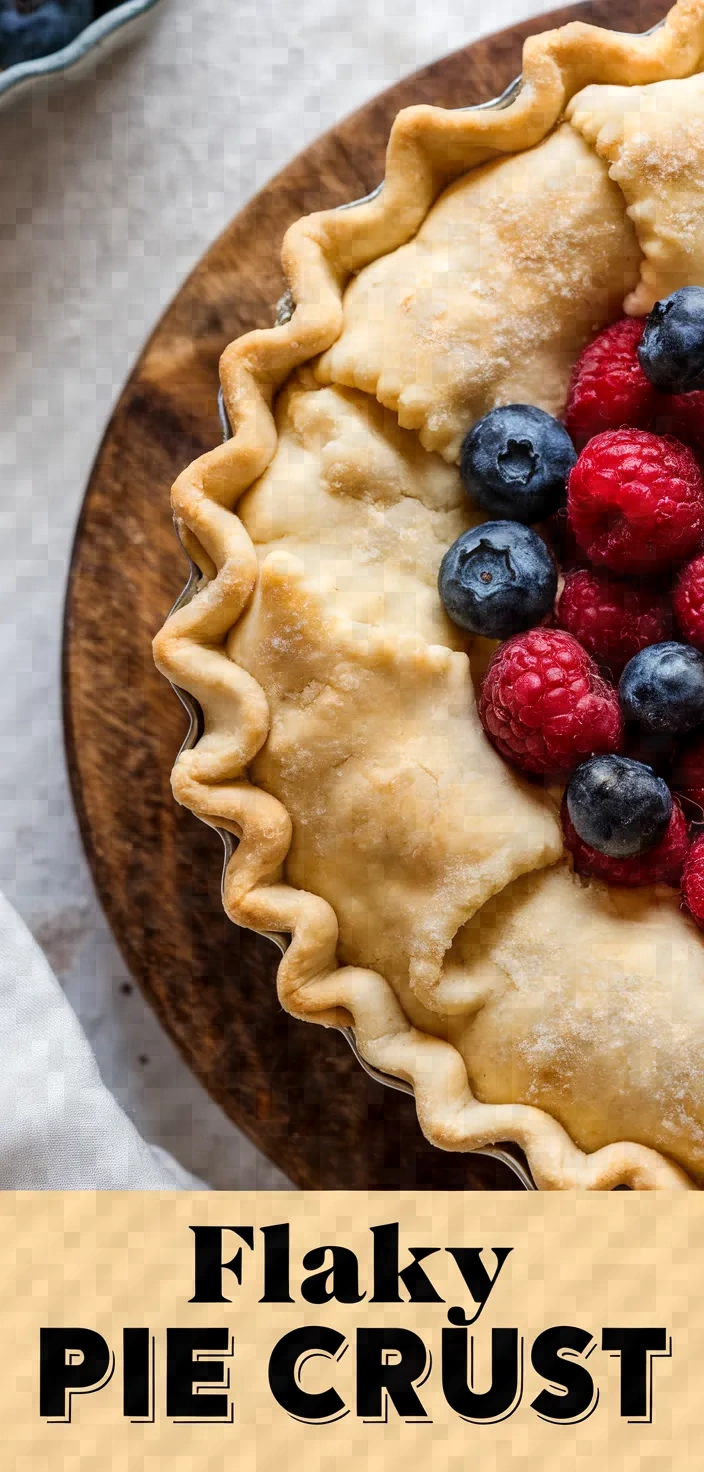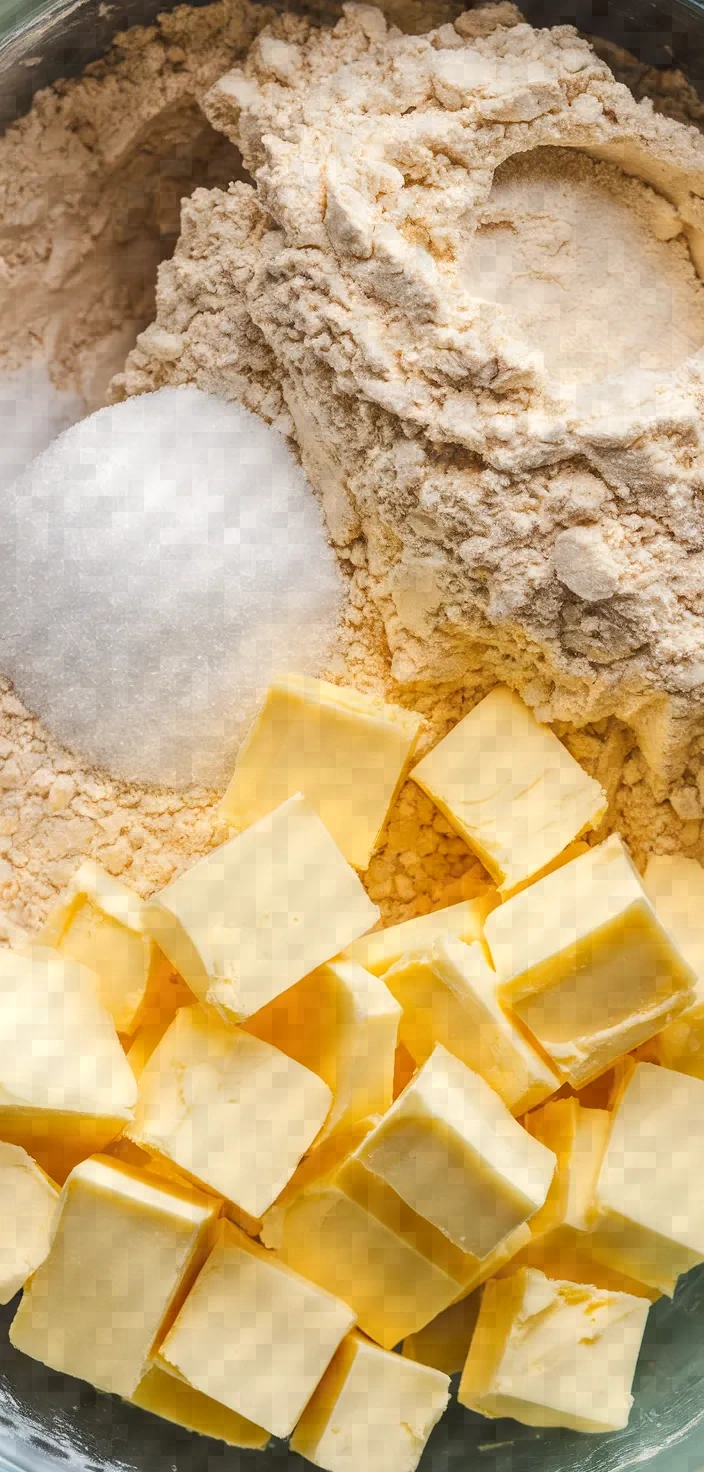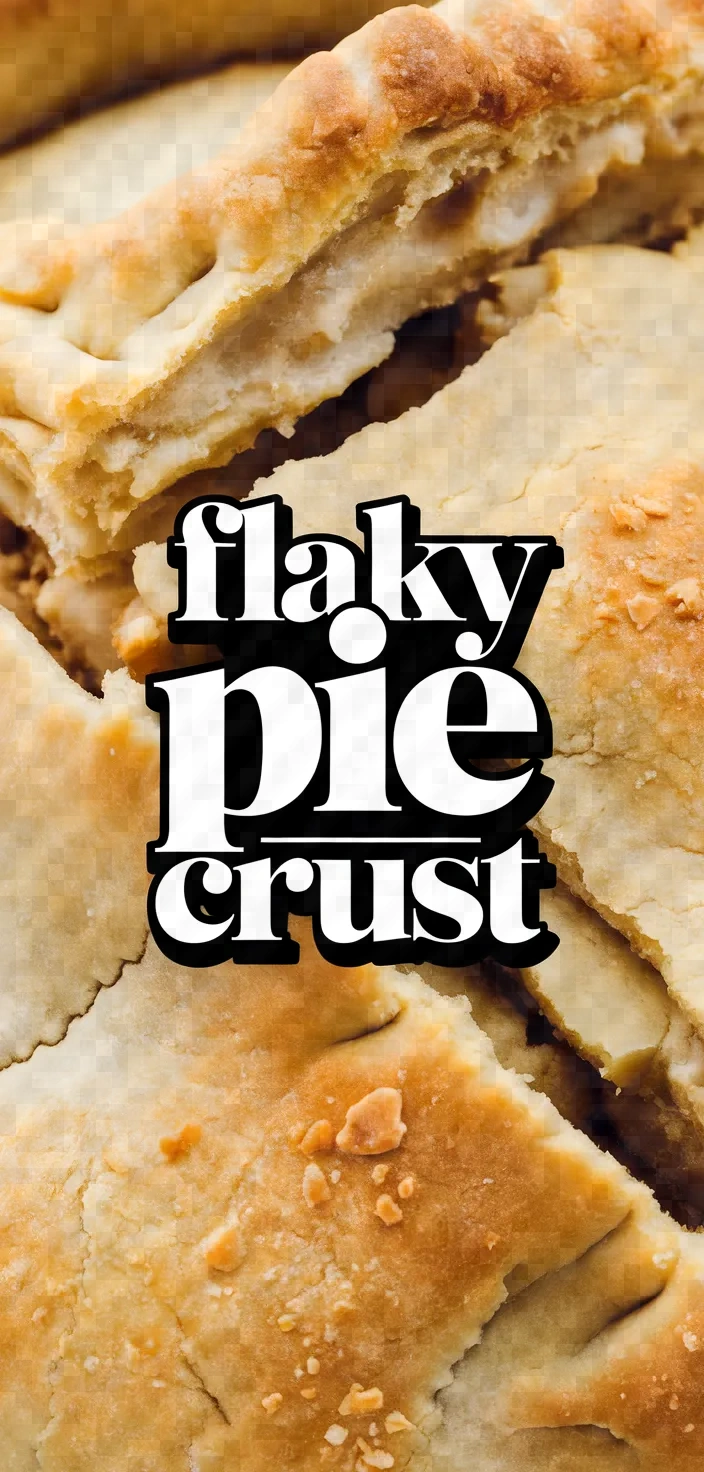Creating a homemade pie crust is a therapeutic experience, akin to a mini journey of artistry in the kitchen. The reward of crafting it with care and seeing it transform into a golden, flaky vessel for your favorite fillings is absolutely worth the effort, trust me.

Mastering the art of making a perfectly flaky pie crust is something I truly love. With only all-purpose flour, a few scant pinches of salt, a tiny hint of sugar, and some chilled unsalted butter, this crust achieves its tender, flaky layers.
Ice water brings these crucial elements together into a balanced base that is rich in texture and flavor.
Flaky Pie Crust Recipe Ingredients

- All-purpose flour: Primary source of carbohydrates, provides structure and texture.
- Salt: Enhances flavor, balances sweetness, and strengthens the dough.
- Granulated sugar: Adds a hint of sweetness, helps in browning.
- Unsalted butter: Provides richness and flakiness, crucial for layers.
- Ice water: Binds ingredients, prevents dough from becoming too warm.
Flaky Pie Crust Recipe Ingredient Quantities
- 2 1/2 cups all-purpose flour
- 1 teaspoon salt
- 1 teaspoon granulated sugar
- 1 cup (2 sticks) unsalted butter, chilled and cut into small cubes
- 1/4 to 1/2 cup ice water
How to Make this Flaky Pie Crust Recipe
1. In a big mixing bowl, combine the flour, salt, and sugar, and whisk until very well mixed.
2. Chill cubed butter, then add it to the flour mixture. Using a pastry blender or your fingertips, cut butter into the flour until the mixture resembles coarse crumbs with small pieces of butter the size of peas.
3. Slowly add ice water, one tablespoon at a time, and stir gently with a fork until the dough begins to form a ball. Be cautious not to overwork the dough.
4. Form the dough into a ball and cut it in half. Shape each half into a disk, wrap them in plastic film, and chill them for at least 1 hour, or refrigerate for up to 2 days.
5. When set to use, take one disk of dough from the fridge and allow it to rest at room temperature for approximately 5-10 minutes.
6. On a surface dusted with flour, roll the lightly floured dough into a circle about 1/8 inch thick and large enough to fit your pie dish.
7. Carefully move the rolled-out dough to the pie plate, ensuring that it fits well into the corners and along the bottom and top edges.
8. Cut any excess dough hanging over the sides so that the overhang is about 1 inch long. Fold the overhang under itself. Crimp the edges as desired.
9. Should your recipe demand a crust that has been baked beforehand, take a fork and poke the bottom, then line the inside with parchment paper, adding pie weights or dried beans so that it doesn’t bubble while it bakes. Then follow the instructions of your recipe to a T.
10. Go ahead and fill your pie or freeze the unbaked crust for later. Enjoy your easily made, flaky pie crust!
Flaky Pie Crust Recipe Equipment Needed
1. Measuring cups
2. Measuring spoons
3. Large mixing bowl
4. Whisk
5. Pastry blender (or fingertips)
6. Fork
7. Plastic wrap
8. Rolling pin
9. Flour sifter (optional, for dusting surface)
10. Knife
11. Pie plate
12. Parchment paper
13. Pie weights or dried beans (optional)
14. Cutting board (optional, for shaping dough)
FAQ
- What is the key to making a flaky pie crust?The crucial point is to maintain the low temperature of the butter and not to labor the dough too much. Butter that is kept cold makes the firm enough to whip and also makes the streamlined structure of the dough condense so that the two structures can fold over one another into a million or so layers. Those layers are what make biscuits flaky. And therein lies the rub: to get layers in dough that is cold enough that the butter will stay a solid lump in the middle, but to get that dough in a shape that can be layered over itself, or just in a form of a simple Siamese twin, like a “figure 8” or something.
- Why does the butter need to be chilled?Chilled butter helps prevent fat from melting before baking, which is key to making the crust tender and flaky.
- How much water should I use?Begin with 1/4 cup of ice water and gradually add more, 1 tablespoon at a time, until the dough barely holds together and is not wet or sticky. This should take about 5 minutes. If working by hand, you may find it easiest to directionally knead the dough in the bowl.
- Can I use salted butter instead of unsalted?Sure, but you ought to cut down or leave out the salt in the recipe to account for the salt in the butter.
- Should I blind bake the crust?For pies with a wet filling, blind baking is typically recommended to avoid ending up with soggy pie bottoms. Before you add the filling, partially bake the crust.
- What can I do if my dough is too crumbly?If the dough is too dry and not holding together, mix in more ice water, one tablespoon at a time, until it becomes cohesive.
- Is it possible to make this crust ahead of time?Certainly, you can prepare the dough in advance and keep it in the fridge for no more than 3 days. You can also freeze it for up to 1 month.
Flaky Pie Crust Recipe Substitutions and Variations
For a nuttier flavor, you can substitute whole wheat flour for all-purpose flour. For a gluten-free option, use gluten-free all-purpose flour.
Substitute granulated sugar with coconut sugar or maple syrup for a different sweetness profile.
Coconut oil or margarine can be used in place of unsalted butter for a dairy-free alternative.
Chilled vodka can be used in place of ice water to inhibit gluten formation and produce a flakier crust.
Pro Tips
1. Use Cold Butter Ensure the butter is very cold before incorporating it into the flour. This is crucial for achieving a flaky texture, as the cold butter creates pockets of steam during baking.
2. Minimal Handling Handle the dough as little as possible to prevent warming the butter with your hands. Overworking the dough can result in a tough crust, so mix just until it comes together.
3. Adjust Water Carefully Add the ice water gradually. The amount needed can vary based on humidity and flour type. The dough should just hold together without being sticky.
4. Chill the Dough Do not skip chilling the dough before rolling it out. This helps relax the gluten, keeping the dough tender, and ensures the butter stays cold, which is essential for flakiness.
5. Even Rolling Roll the dough evenly from the center outwards, rotating it often to prevent sticking to the counter. This helps maintain an even thickness and size suitable for your pie dish.

Flaky Pie Crust Recipe
My favorite Flaky Pie Crust Recipe
Equipment Needed:
1. Measuring cups
2. Measuring spoons
3. Large mixing bowl
4. Whisk
5. Pastry blender (or fingertips)
6. Fork
7. Plastic wrap
8. Rolling pin
9. Flour sifter (optional, for dusting surface)
10. Knife
11. Pie plate
12. Parchment paper
13. Pie weights or dried beans (optional)
14. Cutting board (optional, for shaping dough)
Ingredients:
- 2 1/2 cups all-purpose flour
- 1 teaspoon salt
- 1 teaspoon granulated sugar
- 1 cup (2 sticks) unsalted butter, chilled and cut into small cubes
- 1/4 to 1/2 cup ice water
Instructions:
1. In a big mixing bowl, combine the flour, salt, and sugar, and whisk until very well mixed.
2. Chill cubed butter, then add it to the flour mixture. Using a pastry blender or your fingertips, cut butter into the flour until the mixture resembles coarse crumbs with small pieces of butter the size of peas.
3. Slowly add ice water, one tablespoon at a time, and stir gently with a fork until the dough begins to form a ball. Be cautious not to overwork the dough.
4. Form the dough into a ball and cut it in half. Shape each half into a disk, wrap them in plastic film, and chill them for at least 1 hour, or refrigerate for up to 2 days.
5. When set to use, take one disk of dough from the fridge and allow it to rest at room temperature for approximately 5-10 minutes.
6. On a surface dusted with flour, roll the lightly floured dough into a circle about 1/8 inch thick and large enough to fit your pie dish.
7. Carefully move the rolled-out dough to the pie plate, ensuring that it fits well into the corners and along the bottom and top edges.
8. Cut any excess dough hanging over the sides so that the overhang is about 1 inch long. Fold the overhang under itself. Crimp the edges as desired.
9. Should your recipe demand a crust that has been baked beforehand, take a fork and poke the bottom, then line the inside with parchment paper, adding pie weights or dried beans so that it doesn’t bubble while it bakes. Then follow the instructions of your recipe to a T.
10. Go ahead and fill your pie or freeze the unbaked crust for later. Enjoy your easily made, flaky pie crust!










